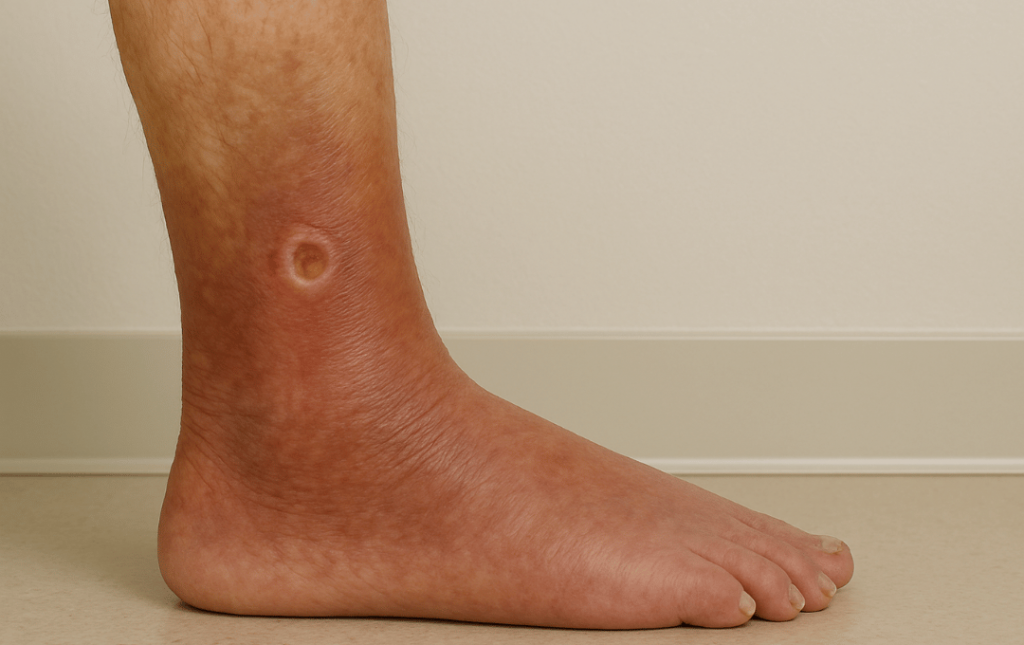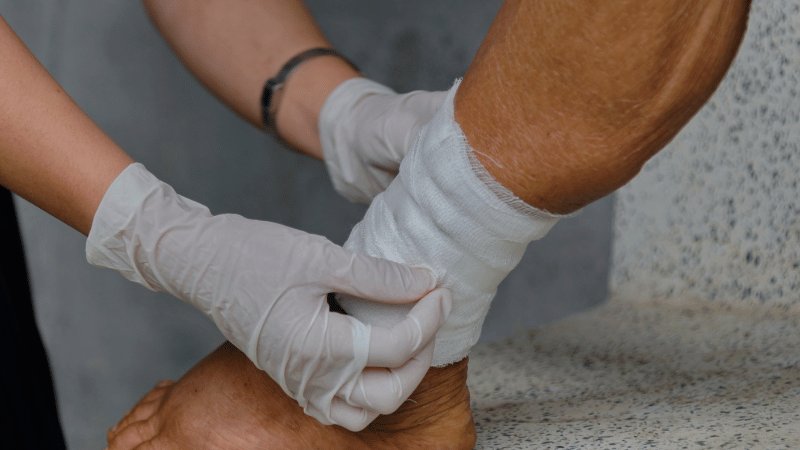A wound that won’t heal isn’t just a skin problem—it could be a sign of a deeper issue, such as peripheral artery disease (PAD), especially if it’s located on the legs or feet. Recognizing signs of non-healing leg wounds and knowing when to seek timely medical evaluation can protect tissue, prevent complications, and determine the best treatment plan tailored to each individual’s needs.
How Long Should a Normal Wound Take to Heal?
Several key factors determine how long it may take for a wound to heal, including wound depth, location, and wound type. Here’s how a few different types of wounds compare:
- Superficial Wounds
- Cause: Cuts, scrapes, and minor abrasions
- Healing time: 1 to 2 weeks
- Deeper Wounds
- Cause: Punctures, sutured cuts, or surgical incisions
- Healing time: 3 to 6 weeks
- Pressure Wounds
- Cause: Injury over bony areas (heels, knees, ankles)
- Healing time: 1 to 9 weeks
All wounds go through four stages of healing: Hemostasis, inflammation, proliferation, and remodeling. Here’s how a typical healing process works:
| Healing Stage | Duration | Process |
| Hemostasis | Immediately | The body works to stop the bleeding |
| Inflammation | 0 to 4 days | White blood cells are transported to the wound to help with healing and reduce infection |
| Proliferation | 4 to 21 days | Blood vessels are repaired, and the body forms new skin |
| Remodeling | 21 days + | Wound fully closes |
Underlying health conditions, lifestyle factors, and certain medications, like steroids, can disrupt the healing cycle and cause delays.
At What Point Is a Wound Considered Non-Healing?
If healing does not progress within two to three weeks of the wound, it may be considered a non-healing wound.
Non-healing wounds are persistently red, tender, and inflamed. If it’s infected, there may also be some swelling and yellow or green discharge.
For wounds that won’t heal or show no noticeable signs of healing after six weeks or are increasing in size, consult with a medical professional for an accurate diagnosis.
Common Causes of Non-Healing Wounds
A range of health conditions can contribute to non-healing wounds on the body. The three most common causes include:
Poor Circulation
Conditions like peripheral artery disease (PAD) restrict blood flow and circulation due to plaque buildup, limiting the flow of essential nutrients to the lower extremities. This can cause wounds to appear on the legs and feet. The wounds are typically dry, pale, and discolored due to a lack of circulation.
Diabetes
High blood sugar levels caused by diabetes can cause nerve damage and interfere with the immune system. This can lead to slow-healing wounds and ulcers on the feet and lower legs. Damaged nerves caused by diabetic neuropathy can also reduce sensation, making it harder to notice or feel the injuries on the lower extremities.
Bacterial Infection or Pressure
Bacterial infections can prevent wounds from healing or slow down the healing process. Pain, swelling, and typically occur near an infected wound.
Prolonged pressure on one area of the body can also cause slow-healing ulcers. This typically occurs on bony areas of the body, such as the heels, ankles, and knuckles.
How Peripheral Artery Disease Affects Wound Healing
Peripheral artery disease (PAD) is caused by the buildup of plaque in the arteries. As the plaque builds up, it restricts the flow of blood, oxygen, and nutrients to the legs and feet. Without healthy blood flow, it’s more challenging for white blood cells and nutrients to reach a wound, which can interfere with the healing process.
Wounds that won’t heal due to PAD are typically on the lower legs, ankles, or feet. PAD-related non-healing wounds are typically painful and discolored due to the lack of blood supply.
Recognizing Wound Healing Complications Early
If you notice a wound on your body that is slow-healing or not healing at all, consult with a vascular specialist for an accurate diagnosis. A delay in treatment or diagnosis can lead to infection, tissue damage, and increased risk of a stroke or even amputation.
Addressing PAD with Help from USA Vascular Centers
USA Vascular Centers offer minimally invasive, non-surgical treatment for patients with PAD. During your initial consultation, a vascular specialist will conduct a thorough evaluation to identify the cause of non-healing wounds and determine if PAD is the underlying cause. When caught early, there are treatments available to prevent the condition from worsening. We have nationwide clinics and accept most major insurance providers, including Medicare and Medicaid. Book a consultation to take the next step toward diagnosis and healing.
Schedule A Consultation Online
FAQs About Wounds That Won’t Heal
How do I know if a wound is not healing?
A wound may not be healing if it hasn’t improved within one to two weeks and shows no signs of closure. Ongoing pain, swelling, redness, or signs of infection, such as odor or pus, may indicate a non-healing or chronic wound.
Is a non-healing wound the same as a chronic wound?
A non-healing wound is the same as a chronic wound, and the terms are commonly used interchangeably. These wounds don’t heal within the expected timeframe and may signal underlying conditions like PAD, diabetes, or infection.
What does a non-healing leg wound look like?
A non-healing leg wound is typically dry, pale, and discolored. Wounds caused by diabetes or PAD may also be painful, red, or swollen.
What’s the difference between a chronic wound and an acute wound?
Acute wounds are typically caused by an injury, such as a cut, burn, or incision, whereas chronic wounds are slow-healing or non-healing wounds that do not follow the typical healing process of a wound.



